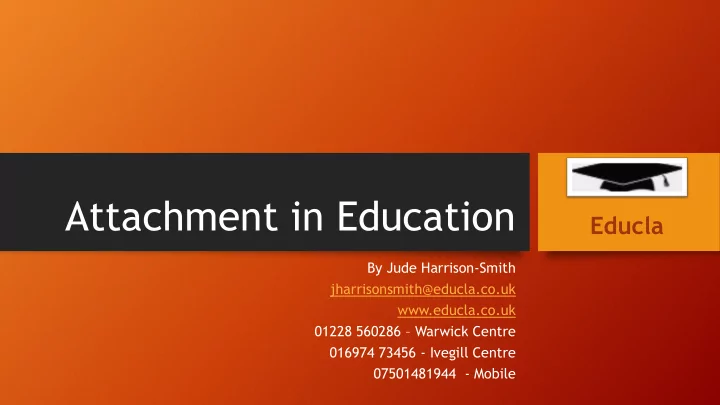

Attachment in Education Educla By Jude Harrison-Smith jharrisonsmith@educla.co.uk www.educla.co.uk 01228 560286 – Warwick Centre 016974 73456 - Ivegill Centre 07501481944 - Mobile
What is attachment disorder? • What do we know already? • Use the paper provided and in pairs or groups, jot down some things you know already about attachment disorder
Attachment disorder Attachment disorder is a broad term intended to describe disorders of mood, behaviour and social relationships arising from a failure to form normal attachments to primary care giving figures in early childhood
Brain Development. Fight, Flight or Freeze
Signs and symptoms of attachment disorder • Fidgety • Manipulating situations • Being superficially charming • Eye contact • Emotionally needy – fishing for • Being indiscriminately affectionate compliments with strangers • Feeling contained • Trying to please others, especially • Being overly demanding or clingy • Authority figure reactions adults • Asking persistent nonsense • Creating chaotic environment • Over reactions questions/incessant chatter • Low self-esteem • Telling lies and/or stealing • Lack of cause/effect thinking • Lack of self-worth • Unwilling to accept help • Pseudo maturity • Sabotaging good things • Emotional functioning • Abnormal eating patterns • Bravado • Interpersonal relationships • Poor impulse control • Struggling to maintain friendships • Cognitive/moral development • Showing increased shame levels • Causing distractions and purposeful • Behaviour • Difficulties with organisation. disruptions • Developmental variations
Classroom strategies • Giving responsibility as with PDA, blame 3 rd party, • Make time to spend talking and listening to them praise work, not the child. Provide concrete, • Be empathic and nurturing; be attuned to their specific and authentic praise; be aware that too response to your nurturance and respond accordingly much praise may be met with scepticism and mistrust • Interact with these students based on their emotional age; some of these children and • Give limited control adolescents may be “stuck” in a younger age of • Teach positive ways to interact with others emotional development and do not have the skills to “act their age” • Provide opportunity to work with peers who will model appropriate social skills • Be consistent, repetitive, and predictable • Interact often with to monitor his/her social • Provide some rewards that are not contingent upon interactions the student accomplishing anything • Reinforce for demonstrating positive, appropriate • Respond consistently and calmly to unacceptable social skills behaviour ; approach with a “matter of fact” voice • Address inappropriate social interactions privately
Classroom strategies • Discipline students with • If they demonstrate poor • Have patience and natural/logical consequences; physical boundaries or understanding and remember avoid consequences. Do not indiscriminate sociability (i.e. that the student is acting give second or third chances. hugging someone who enters from a place of fear and a the classroom) avoid lecturing true belief of worthlessness • Use humour to deflect them; instead suggest a more and un-loveability; each time provocative behaviour. appropriate way “why don’t they are successful in driving • When they misbehave, do not you shake the teachers hand ” people away by their ask “did you…”, “why did behaviour, their world view of you …” what did you…” themselves is only further questions entrenched.
Where we can go wrong: • Prejudism/unconscious bias Unconscious bias is the bias we are unaware of that happens outside of our • Giving control control and automatically. It is triggered • Treats and rewards by our brain making judgements and assessments of people and situations, • Boundaries influenced by our background, cultural • Assumptions environment and personal experiences. We can’t prevent it – just be aware of it
Items to have/help in the school setting • Squishies • Stress balls • Water bottles • Sensory items • Quiet/calm area
Leaflets, websites and books for reference • Dibs – in search of self • Poppies on the rubbish heap • Tory Hayden and Dave Pelzer • www.educla.co.uk
Any questions?
Thank you • Normally, when children feel frightened or in need they seek proximity with their primary caregivers. These biologically programmed behaviours are the basis for forming attachments, and also help to shape brain development. Children whose needs are met by sensitive and available caregivers learn to trust and develop secure attachments (Howe, 2009).
Recommend
More recommend